Star Wars: Dark Empire was a series of comic books written by Tom Veitch and illustrated by Cam Kennedy. They were originally released by Dark Horse Comics between December 1991 and October 1992 as a 6-issue bi-monthly series, which were later compiled and sold as trade paperbacks and hardcovers. The name generally applies to both the original Dark Empire, as well as its two sequels Star Wars: Dark Empire II and Star Wars: Empire's End. All three comic series detailed the resurrection of Emperor Palpatine in clone bodies.
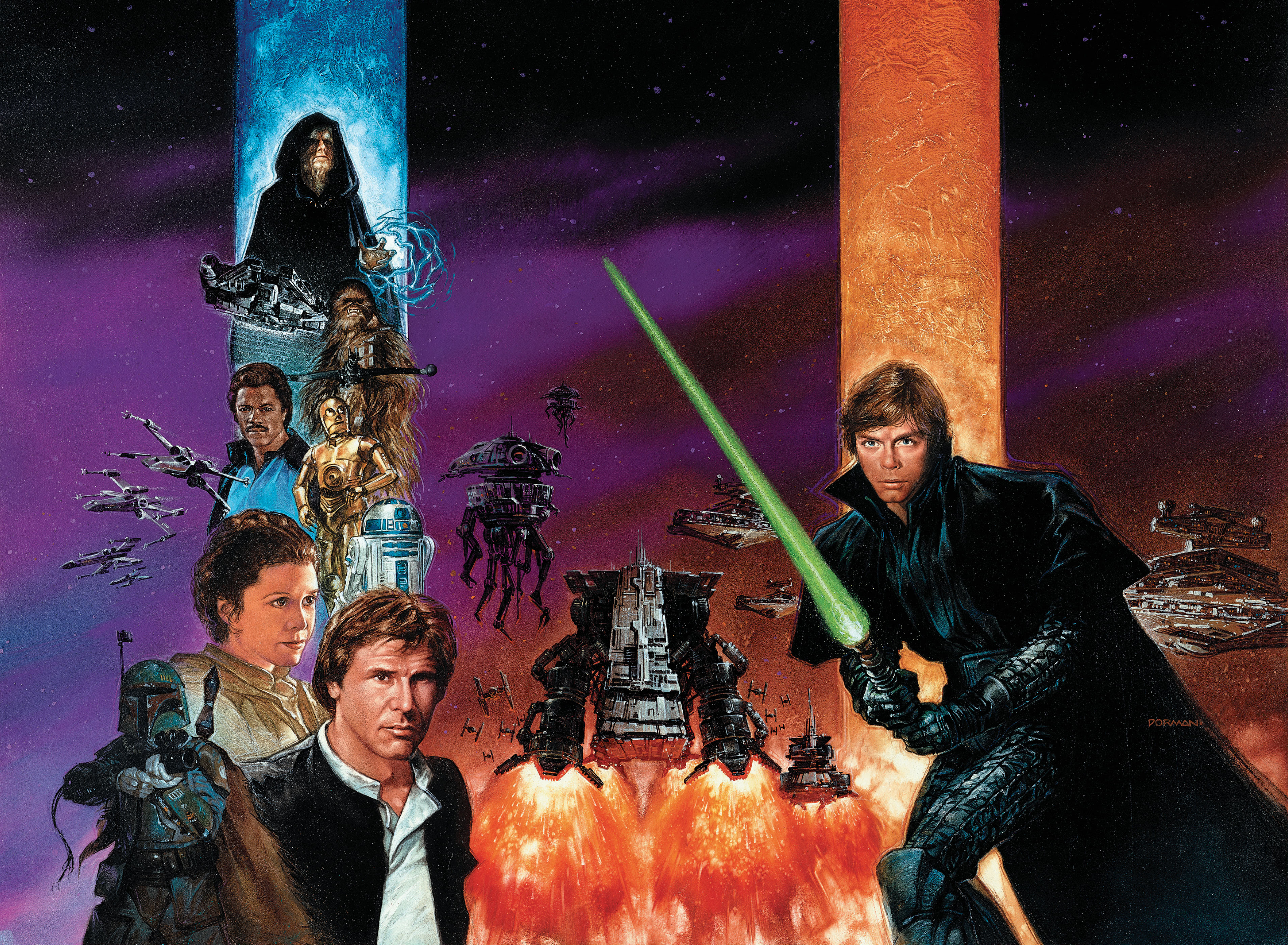
Luke Skywalker in his father's armor with World Devastators and Star Destroyers in the background
Six years after the Battle of Endor, the fight for freedom rages on. Darth Vader is dead, but a reborn Empire—under a mysterious new leader—strikes back at the struggling Rebel Alliance. Massive World Devastators, more powerful and unstoppable than the Death Star, ravage entire planets, while the ruthless heirs of Jabba the Hutt place a monumental price on the heads of Princess Leia and her husband, Han Solo. Along with Lando, Chewbacca, Artoo, Threepio, and other old allies, Han and Leia struggle to protect the future for their unborn child. But their greatest foe may be their closest friend: Luke Skywalker…
During the Imperial Mutiny, the Rebel Alliance sought to weaken the factions as much as possible by surreptitiously entering systems and battles with captured Star Destroyers broadcasting falsified signals, and provoking attacks by one group against another.
On one of these raids to the Coruscant system, in the Star Destroyer Liberator (formerly the Adjudicator), an Imperial-class Star Destroyer captured at the Battle of Endor and, over a five-year period, repaired and modified for covert missions, and its sister ship, the Emancipator (originally the Accuser), entered the Coruscant system, where three Star Destroyers demanded novel and unusual codes for clearance. The codes the Alliance had stolen or bartered with slicers for did not work, and Luke Skywalker and Lando Calrissian were shot down over the former Imperial City. They should have perished, but successfully landed the gargantuan vessel without many casualties on the surface of Coruscant. For the next several days, Luke, Lando, and their forces hid and fought Imperial battalions.
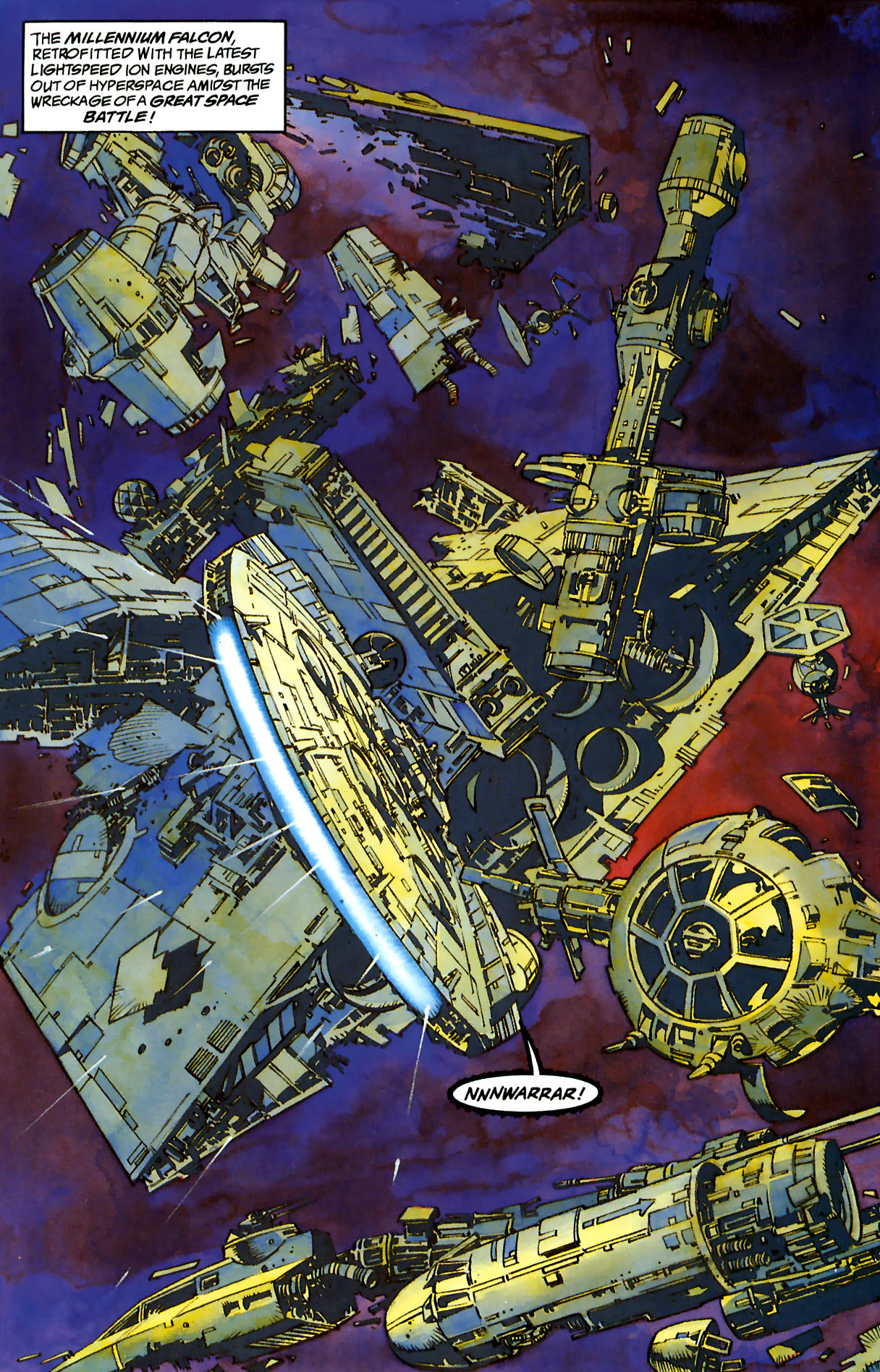
Arrival at Coruscant
When the news reached Han Solo and Leia Organa, they rushed to the rescue along with Chewbacca and C-3PO. They arrived in the nick of time to rescue Lando and the crew of the Liberator. However, Luke informed them of a great disturbance in the Force. At that moment, a Force storm came out of a hyperspace wormhole. Luke told everyone to go, but R2-D2 stayed with him. As the Falcon took off, Luke and R2-D2 were sucked in by the anomaly.
Later, at the Alliance base on the fifth moon of Da Soocha, code-named Pinnacle Base, the Alliance leaders reported that the separate Imperial factions had disappeared into the unknown regions of the Galactic Core. Furthermore, the initial phase of Operation Shadow Hand had begun, launching fleets of World Devastators, brainchildren of Umak Leth: machines which destroyed everything in their path, plunging them into vast furnaces which produced weapons and items which could repair or build new World Devastators. The first target, selected for its long and steadfast support of the Rebellion, was the planet Mon Calamari.
The recently rescued Lando and his crew were dispatched aboard the Emancipator to fight a holding action while the main Rebel fleets assembled.
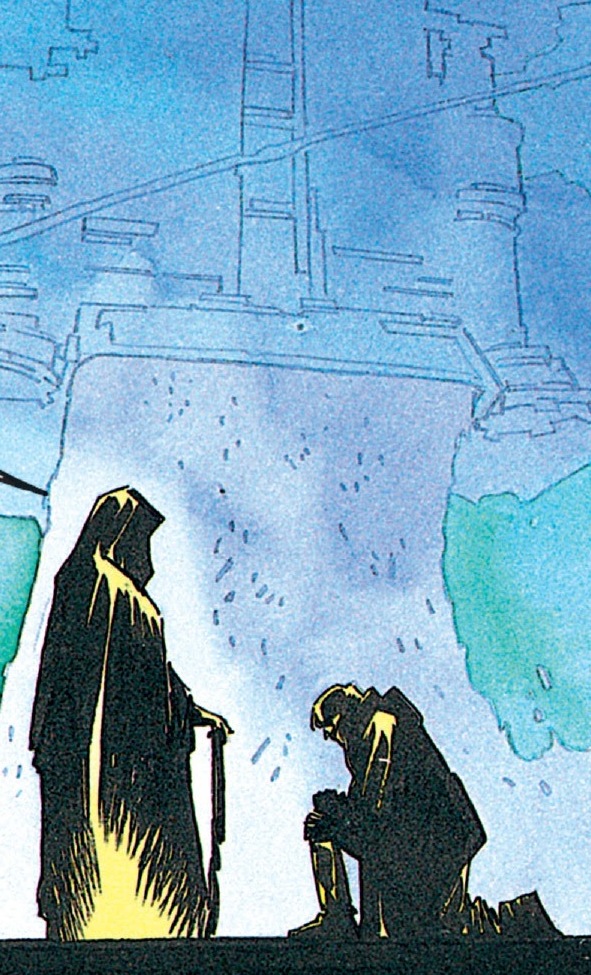
Luke Skywalker kneels before Palpatine.
At this time, Luke Skywalker had reached Byss, a Deep Core world enveloped in the power of the dark side of the Force. There he met face-to-face with the Emperor reborn, who revealed that for many years, he took to transferring his mind and consciousness to clone bodies to attain immortality. However, the clones were one crucial step from long life; they were more ravaged by the dark side than sustained by the Force. But Palpatine had numerous clones to laugh in the face of death, allowing him to rule indefinitely. The Emperor offered him apprenticeship and the prospect of controlling the enormous fleet of Devastators, as well as the rest of the Imperial fleet. Faced with an impossible situation and with a looming threat of doom for his friends and allies, Luke acquiesced to becoming his apprentice, hoping he could defeat the Emperor from the inside. At this time, R2-D2 was modified to carry the Master Signal for the World Devastators.
Meanwhile, Lando's attack force began their attack on the Imperial fleet. Though they were able to break through the Star Destroyer defenses, the Devastator Silencer-7 turned the Emancipator to scrap and launched squadrons of robotic TIEs. This forced the crew of the Republic Destroyer to abandon ship.
At Pinnacle Base, Leia received a message from Luke, telling her not to follow him. Han Solo and Leia Organa Solo had gone to Nar Shaddaa, to find transport to the Deep Core. After landing the Falcon in Shug Ninx's garage, meeting Han's former girlfriend, Salla Zend, Han and Leia went to Han's old living quarters. Along the way, they encountered a woman named Vima-Da-Boda, who gave Leia a lightsaber. Upon arriving at Han's place, they discovered that Boba Fett was alive and that their friend, Mako Spince, betrayed them. Pursued by the hunters, Han and Leia made it to the Starlight Intruder, the ship that brought them to the Deep Core. Meanwhile, the Rebels in combat over the planet Mon Calamari received aid from the Alliance reserves, including the new E-wings. Suddenly, three Devastators fell into the sea because Luke Skywalker shut them down from Byss.
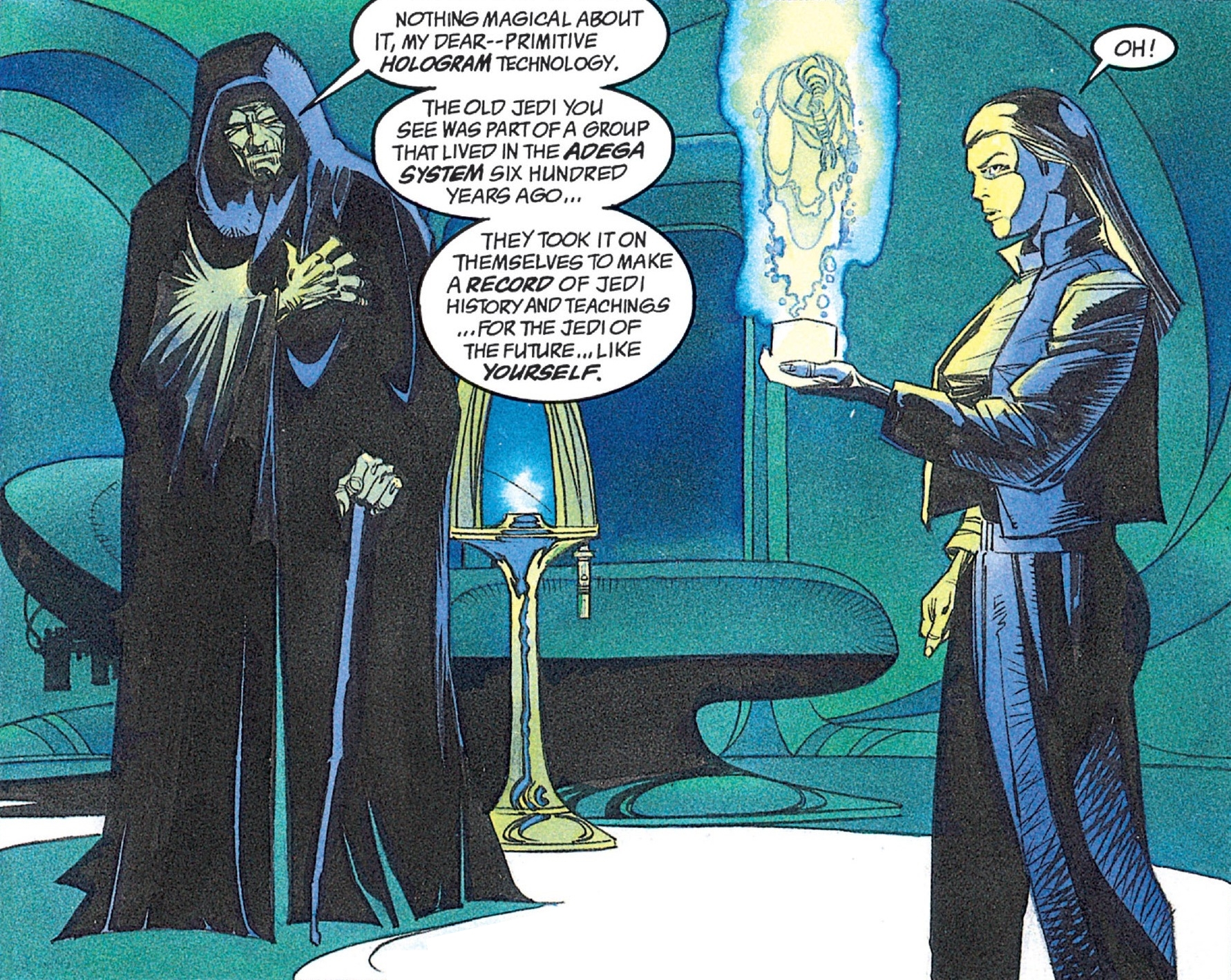
Palpatine attempting to turn Leia
After arriving on Byss and missing Fett by a long shot, Leia piloted the Falcon to the Emperor's citadel. After she, C-3PO, Han and Chewbacca got off, Salla and Shug took the Falcon to a safe place. The four were brought before the Emperor and Luke. Despite trying to fight back, Leia was rendered unconscious and was brought to Palpatine's quarters to be turned. There, she discovered that he held hostage an even greater treasure: a mysterious and intelligent artifact called the Jedi Holocron, which the Emperor had stolen during the Great Jedi Purge from Ashka Boda. With both the Holocron and Luke Skywalker under his control, the Emperor appeared to reign supreme in the Force. He revealed that he planned to overshadow Leia's third child stirring in her womb as his next new body. In anger, Leia toppled Palpatine from his bed and stole the Holocron. She found Luke, who claimed he was free of the dark side, despite his eyes continuing to shine yellow. Meanwhile, Shug and Salla gained control of a Hunter Killer patrol droid to blast Han and Chewie free. After being joined by Leia, Luke and the droids, the Falcon took off from Byss. However, Luke revealed that he had cast an illusory projection of himself to make them believe he had boarded so they would escape.

Luke Skywalker attempts to subdue Palpatine.
The real Luke Skywalker then marched into the clone lab during Palpatine's last few moments before the transition. When he revealed his purpose, Palpatine allowed his current incarnation to die, hoping to reach one of the clones before Luke destroyed them all. Skywalker went on a destructive spree through the lab, hoping to beat Palpatine to the clones. But he missed one.
The newly resurrected Palpatine scoffed at Luke's attempts to vanquish him. When Luke attempted to subdue Palpatine, the Sith Lord seized one of the lightsabers he kept stored in the lab and engaged Luke. Despite his valiant efforts, Luke was disarmed and held at blade-point. Palpatine completed Skywalker's turn to the dark side, reducing him to an obedient watchdog.
Meanwhile, on Mon Calamari, the Devastators were still invincible. However, Luke installed a code into R2-D2's memory banks to shut down the Devastators. Though the great war machines were down, the crew managed to power up the factories until control was restored, but R2-D2 created a new code to make the Devastators recycle each other.
But this was only a small part of the Emperor's plan. Great new fleets of the Empire were spreading across the Galactic Core, and soon the entire galaxy would fall under the sway of the dark side.
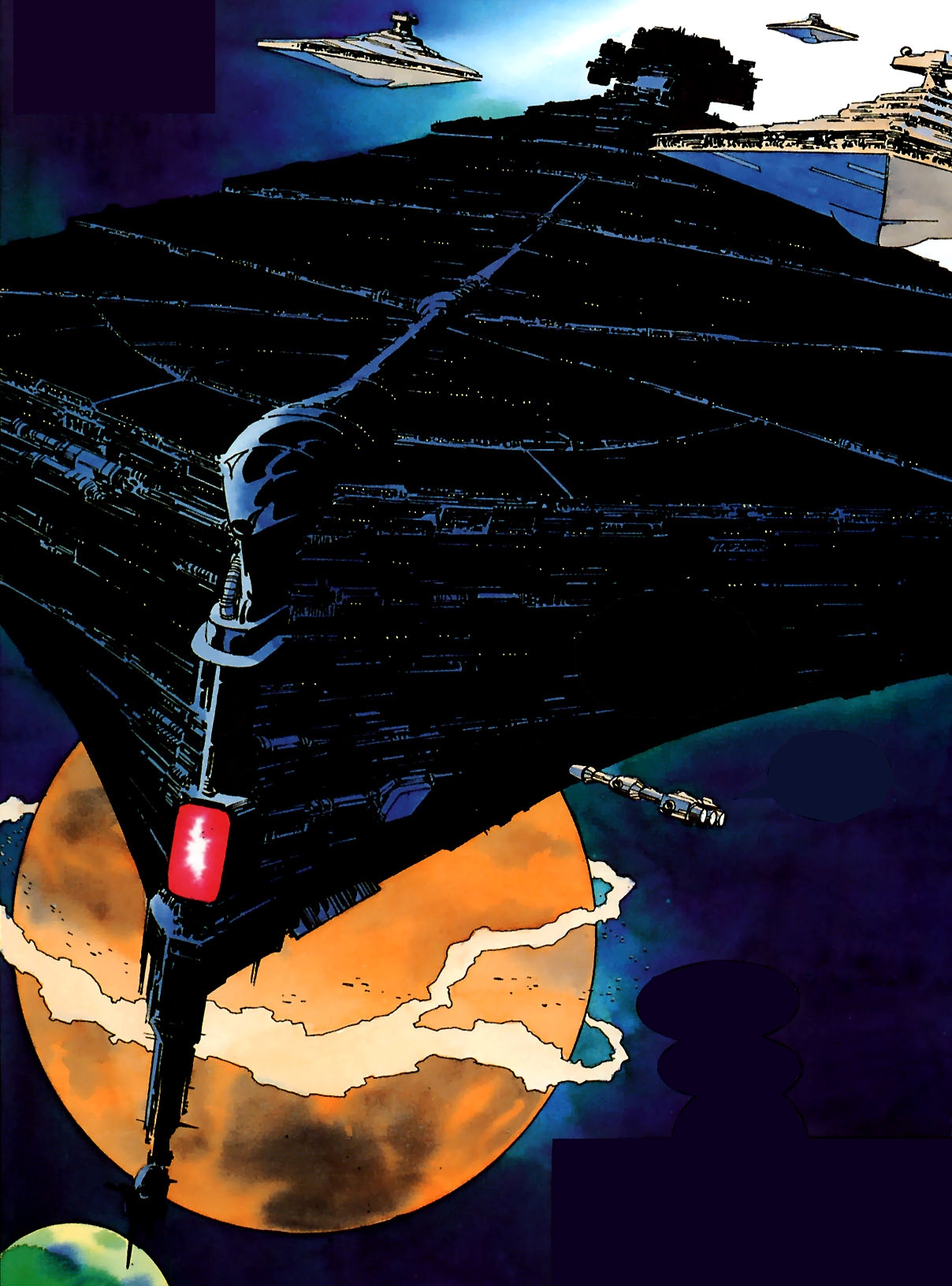
Eclipse arrives at Pinnacle Base.
Luke traveled with the Emperor to capture his sister, aboard the recently completed and christened flagship, the Eclipse. Prior to the Eclipses arrival, the Holocron which Leia had stolen from the Emperor delivered a thousand-year-old prophecy to the Princess, which told of her battle against the young Emperor:

Skywalker vs. Palpatine
As the Eclipse came out of hyperspace, the Emperor made his demands clear to Alliance Command for Leia to come to his flagship alone, with the holocron; he even promised to discuss a truce. Despite Han's objections, Leia boarded the shuttle, which took her to the Emperor's Eclipse-class Super Star Destroyer. It was she who appealed to the good inside Luke, redeeming him. Outraged, the Emperor fought Luke in a lightsaber battle, ultimately losing his hand.
However, an enraged Palpatine unleashed a titanic force storm to obliterate the Rebel Alliance fleet. Using knowledge taught to them, brother and sister turned the Force storm upon its dark master. The result was the destruction of the Eclipse and Palpatine (supposedly, though his spirit escaped to fight another day). As the Eclipse was destroyed, the twins fled on a shuttle. Once safely aboard an Alliance cruiser, Luke, his eyes once again blue, proclaimed:
On November 19, 1988, Tom Veitch sent a short letter to George Lucas proposing a new Star Wars comic book series, to be written by Veitch and illustrated by Cam Kennedy. At that time, no new Star Wars comic books or novels were being published, but Veitch, a long-time fan of the series, believed the franchise to still have further narrative potential outside the film medium. Veitch included samples from his work with Kennedy on The Light and Darkness War series in his proposal, and, although he knew the chances were slim, awaited a reply. Three days later, on November 22, Lucy Autrey Wilson from Lucas Licensing called Veitch back, expressing Lucasfilm Ltd.'s interest in the proposal, pending Lucas' approval of the concept after seeing the creative team's samples. Lucas, a long-time comic book fan, approved the proposal, and on November 29, Wilson called Veitch to inform him the project was a go.
Before the writing process could begin, however, a few important issues had to be addressed -- namely, the familiarity of the artists with the franchise, and what the story would be about. Regarding the first point, Veitch was very familiar with the films, but Kennedy had actually never seen the Star Wars films before. Before beginning work on it, Kennedy watched the films on video cassette, and felt inspired to begin the series. Kennedy then moved from Scotland to Oregon for two years to begin work with Veitch.
When it came to the story concept, it went through several iterations before becoming the comic it became. The first proposal, which Veitch made on December 2, was entitled The Jedi Chronicles and would have been a prequel to the Star Wars original trilogy films. Within this proposal, Veitch described the premise as such: "Our first ambition is to examine the period between the first and second trilogies, when Darth Vader rose to preeminence as 'Dark Lord of the Sith.' We are told that it was during this 20 year span following the Clone Wars that Vader, 'hunted down and exterminated the remaining Jedi' -- all except Yoda and Obi-Wan Kenobi. We would want to focus on the greatness of the martyred Masters, their wise and ingenious use of the Force, their awesome exploits against the Empire, and ultimately their heroic deaths. Our book would end on an upbeat note, with Obi-Wan Kenobi watching young Luke Skywalker from afar, prophesying Luke's role in the struggle and victories yet to come." Lucy Autrey Wilson, Director of Publishing and the Lucasfilm editor who worked with Veitch on the series, rejected this proposal on the grounds that it might interfere with the forthcoming Star Wars prequel trilogy films. She suggested instead that Veitch consider focusing the comic line on the time period after the 1983 film . Veitch and Kennedy subsequently agreed to Wilson's proposed timeline for the series.
Veitch was excited by the prospect of continuing the story after Return of the Jedi, but felt daunted by the task. Still, Veitch was taken in by the opportunities the era provided, later saying: "I leaped at the opportunity to explore the mythological underpinnings of the Force -- both the light and the dark side." Drawing on inspiration from The Light and Darkness War, Veitch sent in a new proposal suggesting the return of Emperor Palpatine to the galaxy. In this proposal, Veitch suggested several possible explanations for Palpatine's return, such as the notion that Palpatine was a machine, along with another suggestion that Palpatine in the films was actually possessed by an extra-galactic "parasitical intelligence." The most lasting suggestion was the idea that Palpatine had been cloned, and through essence transfer had transferred his consciousness from one body to another; his goal of the series would be to eventually do the same with Luke Skywalker's body. It was this proposal that Wilson approved, but the proposed outline would undergo ongoing revisions.
Throughout this process, Veitch was in communication with Archie Goodwin with Marvel Epic about the series. On December 30, 1988, Veitch sent his nine-page proposal to Goodwin, and Goodwin gave his feedback and suggested some ideas of his own. One such idea was the return of Vader's costume; as Veitch would explain, "Archie came up with the idea that the Empire would put somebody else inside Vader's costume, to inspire fear throughout the galaxy." Veitch revised his proposal based on Goodwin's feedback and suggestions, and he then sent in the new proposal to Lucasfilm. Wilson approved Veitch to begin writing scripts based on this outline, but she rejected any use of Vader's costume for the comic book series on the grounds that it could interfere with Lucas' usage of Vader or his likeness for the prequel films. Wilson also approved the usage of the film actors' likenesses as visual inspiration for the drawing of the characters' faces.
Though work on the project had begun, and plans were in place for it to be published with Marvel, Goodwin left the comic book company in May of 1989, and the new Marvel editor did not share Goodwin's enthusiasm for the project, leaving the series in jeopardy. By spring of 1990, the art for the first issue was completed, but contracts were still not finalized with Marvel for the series, resulting in Kennedy not being paid for his work so far. Though a print ad had been released for a three-issue iteration of the series with Marvel, planned for release in fall of 1990, Kennedy was considering leaving the project for other work, due to lack of pay and progress with the series. After more delays over the following months, Kennedy informed Veitch and Wilson that he would have to leave the project to seek other work. Veitch was distraught at the news, but, determined to save the project, suggested other artists to complete the series, such as Andy and Adam Kubert. Wilson was a big fan of Kennedy's art style, referring to it as 'brilliant,' and refused to let further problems with the series lead Kennedy to leave it, leading her to explore other options to expedite its publication.
In a fortuitous turn of events, Mike Richardson, owner of Dark Horse Comics, had seen some of Kennedy's artwork for the first issue of Dark Empire and was very interested in taking on the project. Richardson, who was friends with Kennedy, believed he could bring Kennedy back into the project if Dark Empire was published with Dark Horse. In August of 1990, at the San Diego Comic-Con, Richardson and Randy Stradley met with Wilson to discuss publishing Dark Empire at Dark Horse, and they also proposed the idea of Dark Horse acquiring the Star Wars license for comic books. Although Marvel would lobby to publish the comic book, Wilson chose to pursue the transfer of the Lucasfilm comic book license from Marvel to Dark Horse. Dark Empire had found a new home, and with it, a new avenue for publication; in December of 1990, Veitch wrote to Kennedy to bring him back on board the project.
As work restarted on the project, new continuity issues arose with the new production of the first in a line of new Star Wars novels: Timothy Zahn's 1991 novel Heir to the Empire. The Lucasfilm editorial staff realized that if the two projects were not in proper continuity with each other, it could hurt sales; with this in mind, they asked Zahn and Veitch to review each other's outlines. However, both authors had very different visions of the universe, and they could not agree on a unified vision. After Veitch initially proposed Dark Empire take place one year after Return of the Jedi, Zahn was not inclined to reference the events of that series, possibly leading to a conundrum in the timeline; Veitch proposed to Lucasfilm a simple resolution: he would set Dark Empires events one year after Zahn's books and write an opening scroll to bridge the two projects. Lucasfilm agreed, and the timeline was set. Work continued on the series, and the first issue of Dark Empire was published on December 12, 1991, almost exactly three years after the first proposal for the series was made.
In 1992, Veitch explained, “Lucy Wilson said to us, you can't bring back Vader, but you can bring back the Emperor... if you can figure out how to do it.” In subsequent years, Veitch claimed in different interviews that George Lucas himself was involved in the development of the project. Star Wars Insiders series of retrospectives on the creation of the series in 2015 clarified that Veitch's editorial contact throughout the development of the series was Wilson. This was further illuminated in 2022, when Wilson spoke about the development of the series, saying: "Tom Veitch, the story he wrote... You know, we were kind of letting people do what they wanted then. He wrote his story. I didn't ask George anything."
The release of Dark Empire was enormously commercially successful, and effectively restarted the Star Wars comic book publishing program. As artist Cam Kennedy recounted, "Previously, Marvel had been selling about 4 to 5 thousand copies a month, and they had to sell about 7 and a half to cover costs. So it wasn't going anywhere. The first Star Wars I think we did, we did about 220,000. Which was good, and obviously Lucasfilm was very delighted. It kept selling and selling." Michael Kogge, writing in a series of retrospectives on the series for Star Wars Insider in 2015, wrote that the success of Dark Empire "stunned the comics world" and "changed how licensed properties were handled in the industry."
Many in the industry were enthusiastic in their praise for the comics' painted artwork. Dark Horse editor Barbara Kesel commented, "Cam's painted art was a striking new approach for comics, let alone 'licensed' comics. The intense colors and watercolor approach were so visually different from the average comics of the time that the series would have stood out on the stands even without a good story." Dark Horse owner Mike Richardson would proclaim, "Cam Kennedy is the best Star Wars artist in comics. Nobody else even comes close." Kennedy would later tell the story about how, at a New York convention, the famed French artist Moebius exchanged some of his own art for that of Dark Empire.
Legendary Star Wars concept artist Ralph McQuarrie would also praise the artwork of the series, going on to write the introduction for Dark Empire II. In it, McQuarrie enthused about the original run of Dark Empire, writing: "I haven't been an avid collector of comics and science fiction or fantasy art, but I've seen quite a lot, and I'll say the work in the Dark Empire series is very impressive. I look with envy at the crisp, stylized drawings by Cam Kennedy, the rich color and painterly effects Dave Dorman gets into his work." McQuarrie would even go further in his praise, adding: "I'm certain Cam Kennedy or any number of people could have read the script I read and designed the things as well or better."
George Lucas had a multifaceted response to the comic. Regarding Lucas' response to the story of Dark Empire, Lucy Autrey Wilson recounted in 2022, "Later, George would run into me and he would say, "You know, Lucy, I would never clone the Emperor. He doesn't get cloned!" And I'm like, "How am I supposed to know that if you don't want to be involved in what we're doing? And yeah, if I do something you don't like?" So I started then having to send him memos. You know, this person wants to do this, this, and this; is this okay, is that okay." It was the publication of Dark Empire that prompted Lucas afterwards to take a more participatory role in the creation of the following stories in the Expanded Universe, with more oversight from him in the form of reviewed memos and outlines.
Lucas did, however, respond favorably to the artwork of the comic; he bought 14 of the 16 art pieces that Dorman created for the series. Lucas would proceed to give the collected issues to the employees of Lucasfilm as part of the annual Christmas gift. Lucas would eventually also choose to include cover art by Dorman from the series in his collection of favorite Star Wars comic art pieces as part of the Star Wars Art: Comics book.
Some contributors to the Expanded Universe made known publicly their dissatisfaction with the decision to bring Palpatine back to life, including Del Rey editor Shelly Shapiro. In Vision of the Future, Timothy Zahn included a conversation that refers to the events of Dark Empire with Luke Skywalker mentioning "the resurrected Emperor" and Mara Jade retorting, "Whatever. Personally, I'm not convinced it was actually him."
One of the events of the series, the Battle of Calamari, was featured as a playable level in 1998's Rogue Squadron game, where the player can fly a New Republic V-Wing against the World Devastators, in defense of Mon Calamari.
Characters and events mentioned in the holocron used in Dark Empire later formed the basis of the original Tales of the Jedi series.
The Sith surviving after Star Wars: Episode VI Return of the Jedi has been adopted by the rest of the Expanded Universe, taking as examples Lumiya, Darth Caedus or the One Sith.
The sequel trilogy, of the later canon continuity, used the idea of Palpatine's resurrection from this comic.
- "Star Wars Publications Timeline" — Star Wars Insider 23
- "Boba Fett: Mystery Man in Not-So-Shining Armor" — Star Wars Galaxy Magazine 1
- The Secrets of Star Wars: Shadows of the Empire
- "Novel Approach" — Star Wars Insider 66
- "Blaster" — Star Wars Insider 151
- "Of Rebel Dreams and Dark Empires: The Making of a Star Wars Legend" — Star Wars Insider 157
- "Of Light and Darkness: The Making of Dark Empire – Part II" — Star Wars Insider 158
- "Death to the Dark Side!: The Making of Dark Empire – Part III" — Star Wars Insider 159
- "Adventures in the Audiosphere" — Star Wars Insider 201